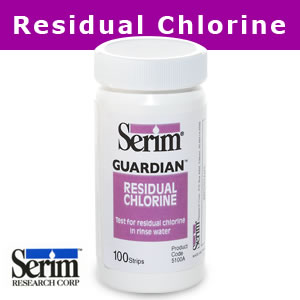
GUARDIAN™ RESIDUAL CHLORINE TEST STRIPS
Serim® GUARDIAN™ Residual Chlorine Test Strips give a semi-quantitative indication that the chlorine bleach solution has been adequately rinsed from the hemodialysis machine, bicarb jugs, bicarb mixing tanks or water delivery systems following disinfection.
If hemodialysis machines are disinfected with bleach, it is important to ensure that the disinfectant has been properly rinsed and any residual chlorine is below the concentration that may potentially cause adverse patient events, such as allergic reactions, hemolysis and death.1,2
AAMI Hemodialysis Water Quality
Guidelines set the maximum allowable
concentration of free chlorine at 0.5 ppm,
therefore the concentration of residual
bleach must be below 0.5 ppm prior to initiating dialysis.1,2,3,4
- Product Profile
- Product Uses
- How To Use
- Products
| SERIM GUARDIAN RESIDUAL CHLORINETEST STRIPS | |
| Features | Benefits |
| Reliably detects 0.5 ppm chlorine concentration in rinse water |
|
| Strip results not affected by common water constituents |
|
| Labeled for dialysis use6 |
|
| Convenient packaging options |
|
| Consistent color reactions |
|
| Simple procedure |
|
| Test strip can be immersed into sample or held in sample stream |
|
|
|
| Simple to interpret color blocks |
|
| Ready-to-use strips |
|
| Each bottle clearly labeled with: • Lot number • Expiration date |
|
HemaStix is a registered trademark of Bayer Healthcare LLC
References:
1. Chloramines in Municipal Water: Considerations for Dialysis Facilities, Nephrology News & Issues, October 1997, pg 19-20
2. Dialysis Therapy, 3rd Edition, pg 76. Hanley & Belfus, Inc., Philadelphia
3. Proper Mechanisms for Assuring Disinfectant Concentrations for Use in Hemodialysis, Nephrology News & Issues, June 1999, pg23.
4. AAMI Standards and Recommended Practices, Dialysis, 2008 Edition, RD62 - Water treatment equipment for hemodialysis applications, Association for the Advancement of Medical Instrumentation. Arlingston, Virginia.
5. NANT Dialysis Technology - A Manual for Dialysis Technicians, 2nd Edition (2000), page 255. National Association of Nephrology Technicians/Technologists, Dayton, OH.
6. Proper mechanisms for assuring disinfectant concentrations for use in hemodialysis. Nephrol News Issues. 1999 Jun;13(6):18, 23, 27. Arduino MJ.
WHAT does this product do?
Serim® GUARDIAN™ Residual Chlorine Test Strips give a semi-quantitative indication that the chlorine bleach solution has been adequately rinsed from the hemodialysis machine, bicarb jugs, bicarb mixing tanks or water delivery systems following disinfection.
WHY should I use this product?
If hemodialysis machines are disinfected with bleach, it is important to ensure that the disinfectant has been properly rinsed and any residual chlorine is below the concentration that may potentially cause adverse patient events, such as allergic reactions, hemolysis and death.1,2
AAMI Hemodialysis Water Quality
Guidelines set the maximum allowable
concentration of free chlorine at 0.5 ppm,
therefore the concentration of residual
bleach must be below 0.5 ppm prior to initiating dialysis.1,2,3,4
WHERE do I use this product?
Use Serim GUARDIAN Residual Chlorine Test Strips to test rinse solution from the drain line of the hemodialysis machine or appropriate sampling points of the bicarb mixing tanks or jugs and water systems.
WHEN do I use this product?
Use Serim GUARDIAN Residual Chlorine Test Strips after rinsing the bleach solution from the hemodialysis system and prior to initiating dialysis.
References:
1. Chloramines in Municipal Water: Considerations for Dialysis Facilities, Nephrology News & Issues, October 1997, pg 19-20
2. Dialysis Therapy, 3rd Edition, pg 76. Hanley & Belfus, Inc., Philadelphia
3. Proper Mechanisms for Assuring Disinfectant Concentrations for Use in Hemodialysis, Nephrology News & Issues, June 1999, pg23.
4. AAMI Standards and Recommended Practices, Dialysis, 2008 Edition, RD62 - Water treatment equipment for hemodialysis applications, Association for the Advancement of Medical Instrumentation. Arlingston, Virginia.
5. NANT Dialysis Technology - A Manual for Dialysis Technicians, 2nd Edition (2000), page 255. National Association of Nephrology Technicians/Technologists, Dayton, OH.
6. Proper mechanisms for assuring disinfectant concentrations for use in hemodialysis. Nephrol News Issues. 1999 Jun;13(6):18, 23, 27. Arduino MJ.
HOW TO USE GUARDIAN Residual Chlorine Test Strips
Serim GUARDIAN Residual Chlorine Test Strips are supplied in ready-to-use form. The strips can be used as a quick, qualitative screening test; detecting concentrations of bleach above or below the 0.5 ppm AAMI action level.
The strips can also be used as a semi-quantitative method to estimate chlorine concentrations between 0 and 5 ppm. When placed in contact with the sample according to the directions for use (see below), the indicator pad changes color relative to the concentration of chlorine.
| Test Method | Qualitative (Stream) | Semi-quantitative (Immersion) |
| Sample | Preferably test the rinse solution at the drain. | Collect a sample of rinse solution from the drain. |
| Test Strip Technique | Hold the indicator pad in the rinse stream for 5 seconds. | Immerse the indicator pad into the sample of rinse solution and move the strip back and forth vigorously through the sample for 30 seconds. |
| Results | Any color indicates a residual chlorine concentration of 0.5 ppm and above. | Remove the strip from the sample and within 10 seconds compare the color of the indicator pad to the color blocks on the bottle label. |
| Store bottles of Serim GUARDIAN Residual Chlorine Test Strips at temperatures between 15°- 30°C (59°- 86°F). The lot number and expiration date are printed on the bottom of each bottle. |
||
 |
GUARDIAN™ RESIDUAL CHLORINE TEST STRIPS | |||
| Product | Description | Packaging | ||
| 5100A 5100C |
Residual Chlorine Test Strips Residual Chlorine Test Strips |
6 Bottles of 100 Test Strips / Kit 12 Bottles of 25 Test Strips / Kit |
||
